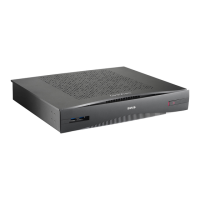R5900049 /13 ClickShare CSE-80036
3.1 Environmental Condition Check
Environment condition check
For installations in environments where the device is subject to excessive dust, then it is highly advisable and
desirable to have this dust removed prior to it reaching the device clean air supply. Devices or structures to
extract or shield excessive dust well away from the device are a prerequisite; if this is not a feasible solution
then measures to relocate the device to a clean air environment should be considered.
It is the customer's responsibility to ensure at all times that the device is protected from the harmful effects of
hostile airborne particles in the environment of the device. The manufacturer reserves the right to refuse repair
if a device has been subject to negligence, abandon or improper use.
Ambient temperature conditions
Max. ambient temperature : +40°C or 104°F
Min. ambient temperature: +0°C or 32°F
Storage temperature: -10°C to +60°C (14°F to 140°F)
Humidity Conditions
Storage: 0 to 90% relative humidity, non-condensing
Operation: 0 to 85% relative humidity, non-condensing
Environment
Do not install the device in a site near heat sources such as radiators or air ducts, or in a place subject to
direct sunlight, excessive dust or humidity. Be aware that room heat rises to the ceiling; check that
temperature near the installation site is not excessive.
3.2 Basic Workflow
Before using CSE-800
1. Unpack the ClickShare components and accessories from the box.
For a detailed overview of the content of the CSE-800 box, see “About the CSE-800”, page 26.
2. Install the Base Unit in the meeting room using one of the 2 possible installation methods.
For more information on the installing procedures, see “Installation methods for the Base Unit”, page 38.
3. Mount the antennas.
4. Connect the video signals between the Base Unit and the displays.
5. Connect the audio from the Base Unit to the meeting room's sound system (only required for audio via
jack, cinch or SPDIF).
6. If configuration via a network is needed, connect a network cable between the Base Unit and the local
network.
7. Connect the Base Unit to the mains power.
For more information see “Power connection and switching on”, page 49.
8. If needed, connect any input to the CSE-800.
9. If desired, configure CSE-800 via the Configurator.
For more information on the different ways to configure CSE-800, see “CSE-800 Configurator”, page 57
For more information on using CSE-800, refer to the CSE-800 User Guide. This manual can be
found on Barco's website www.barco.com/clickshare.
Getting started

